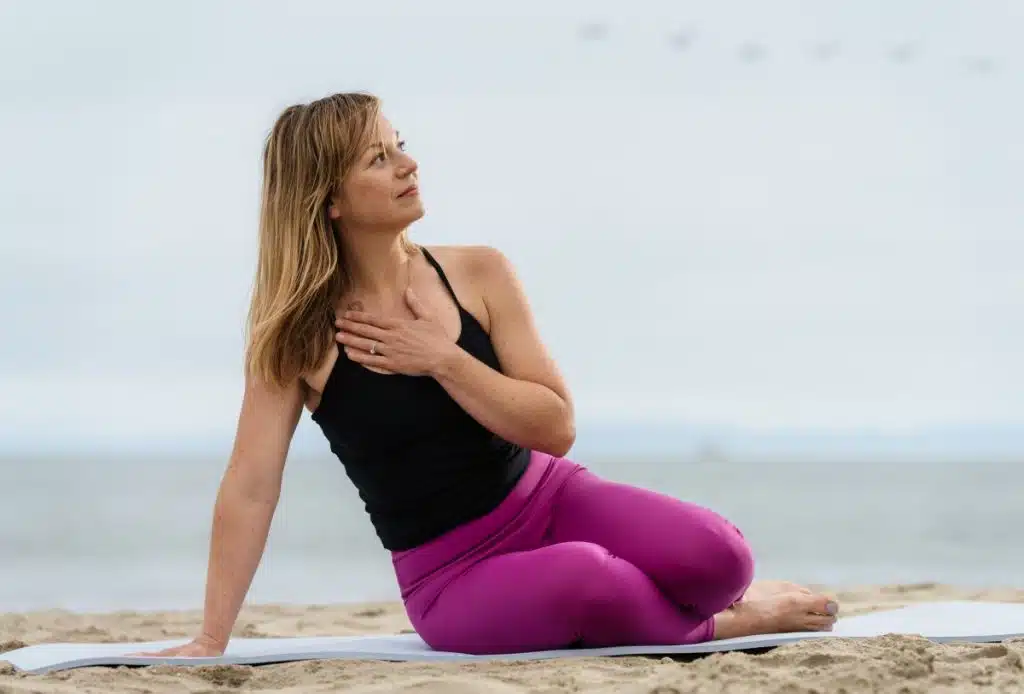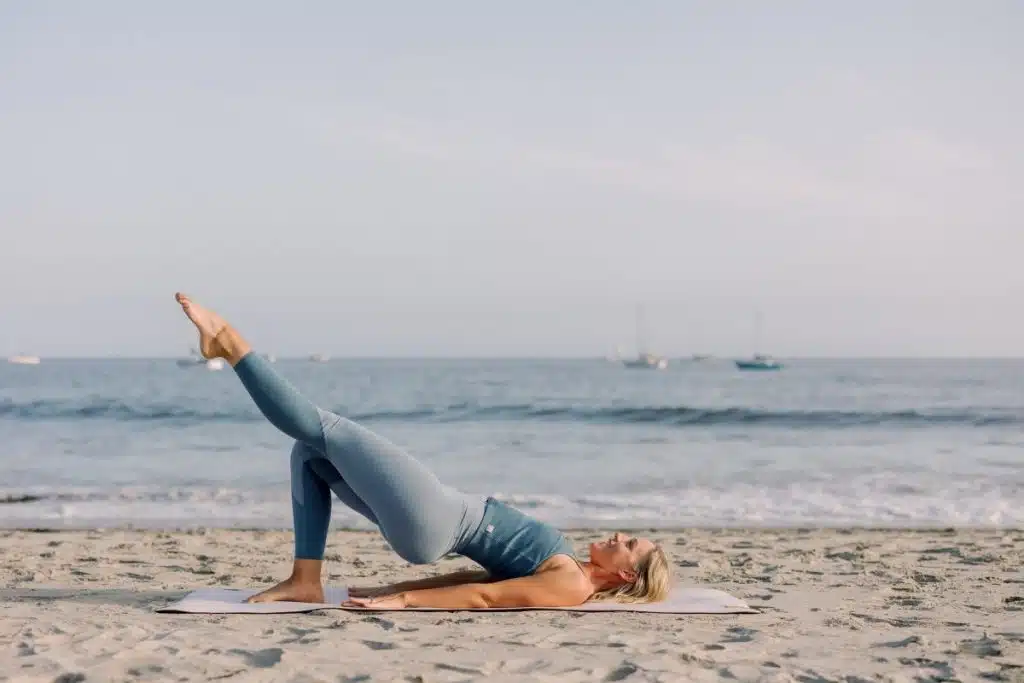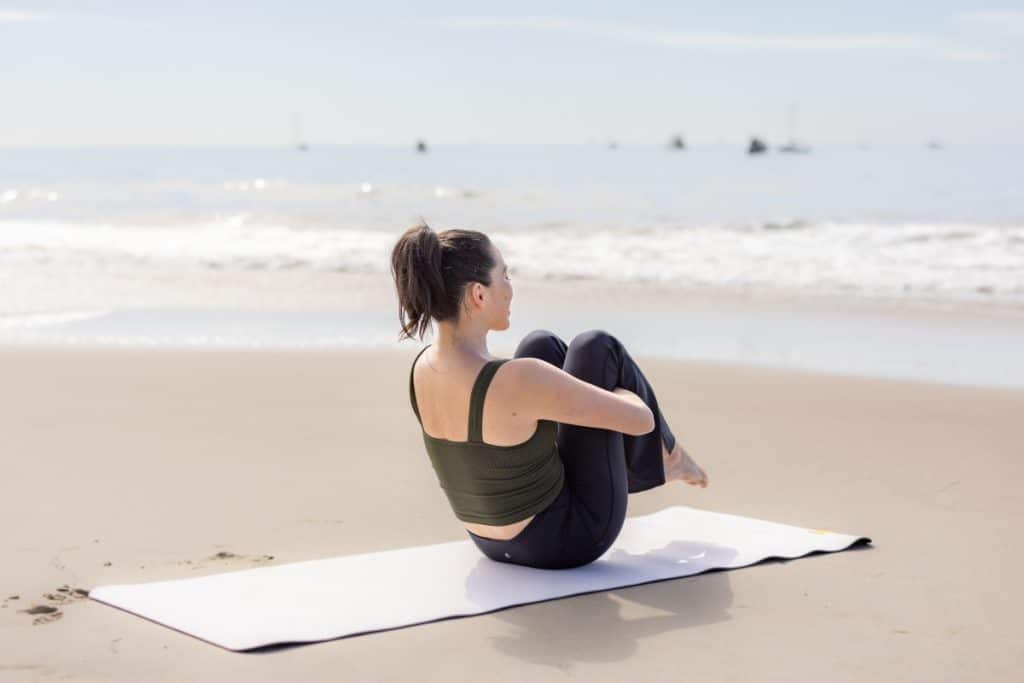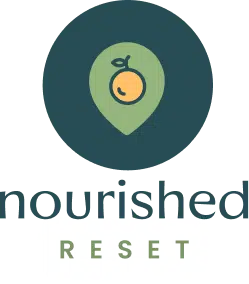
Wholistic fit living is a different way of thinking about health, wellness, and fitness. Ultimately, it gives us a chance to zoom out.
When you hear the word, “health,” usually exercise or diet comes to mind, right? Of course, these things are important for us to feel our best, but long-term wellness is about so much more than that. Real, sustainable health needs a wholistic, or whole body, approach, especially as we work to embrace joyful aging and feeling great in every season of life.
This is where the 8 Dimensions of Wellness, developed by Dr. Margaret (Peggy) Swarbrick, come into the picture. While there are many ways to think about wholistic health, I love that this framework makes it easy to connect with and see how each area of our lives impacts us.
Each of these pillars dives beneath the surface to examine:
- How you move through the world
- What you think and feel
- Who you interact with
- How you allocate your time or resources
- Which values, habits, or beliefs you practice
When creating your roadmap to mind-body health, so you can feel your best in every season, all of these factors play a role—so let’s look at how.

The Physical Dimension
The health industry often focuses on this dimension; the strength, resilience, and function of your body—and it’s important. However, where the fitness industry often gets it wrong is the focus on pushing your body at all costs and doing more than your body can handle. This mentality can lead to injury and a start-and-stop way of working out—which means you aren’t reaping the benefits of physical fitness because you’re not being consistent (or are continually hurting yourself).
The physical dimension best serves your health when you meet your body where it’s at and choose movement that not only feels good but uses proper form so you avoid injury and pain.
Put It Into Practice: While there are many ways to choose the right movement for your body, strength training is one of the best formats for building long-term muscle. Instead of going to the gym and figuring it out yourself, start a 14-day free trial of Lindywell and get instant access to our Weight Training Series. This will allow you to build strength with weights while being very intentional with your movements, leading to better results and less pain and injury.
The Intellectual Dimension
This dimension refers to pursuits and behaviors that sharpen your brain and reduce the risk of cognitive decline. It’s about immersing yourself in new skills or information, maintaining a sense of curiosity, and seeking out intellectual enrichment. This may not sound important to your health, but data shows that those who identify as “lifelong learners” report more:
- Self-efficacy
- Intrinsic motivation
- Alertness, retention
- Flexible thinking
- Positive mood state
They’re also less susceptible to chronic stress, depression, or other mental health issues. All of this is key to your mental health and wellness, which in turn, of course, affects every single area of your life.
Put It Into Practice: Challenge yourself to develop a new hobby, whether it’s learning how to speak a new language, crocheting a scarf, or planting a garden. I love learning about interior design to create a life-giving and comfortable home that impacts all areas of my life—from enjoying the learning experience itself to implementing new things in my home.
The Emotional Dimension
This dimension refers to the awareness of your emotions, modulating them in a constructive way, and respecting the emotions of others. Research shows that the ability to determine how you feel, and then use healthy coping or problem-solving skills to deal with that emotion, referred to as emotional regulation, can boost quality of life and alleviate clinical symptoms.
Those who regulate their emotions also tend to prioritize other beneficial habits such as nutrition, fitness, sleep hygiene, and stress or anxiety management.
Put It Into Practice: One way to improve your emotional awareness is breathwork. An intentional breathwork practice will teach you to be mindful of emotions while accepting them without judgment. It can also help you tap into your self-compassion, release feelings that do not serve you, and return to a state of calm rather than staying in a stress state.
If you want to practice breathwork with some guided support, join one of live our Exhale Hour sessions.
The Social Dimension
This is an area of wholistic fit living that is rarely ever connected to health in our modern wellness culture—but is so incredibly important. Loneliness and isolation can actually worsen health outcomes whereas, a sense of connection with community and friends will improve them. A thriving social circle (even if it only includes a few people!) can:
- Reduce inflammation in the body
- Increase metabolic function
- Relieve depression or anxiety
- Lower the risk of cardiovascular issues, pulmonary disease, or high blood pressure
You can learn more about how friendships impact your health through the work of Dr. Andrea Bonior, one of the most well-known researchers in this space. Her book The Friendship Fix shares fascinating data and stories that illuminate the importance of this dimension of health.
You can also dig deeper into connection in my new book Well to the Core, where I share about the power of community and its impact on our health. I also share some simple but actionable strategies for creating deeper connections within your world.
Put It Into Practice: Creating social connections and cultivating the ones you already have takes intentional practice as an adult. Start by planning a date night if you have a partner—even if you can’t leave the house (hi parents, I see you!).
To connect with current friends, invite them to do something, like take a pottery class or get coffee. If you’re looking to build your social circle, consider ways that you can meet people who align with your values, like joining a book club, taking an art class, or finding another meet-up in the community.
The Spiritual Dimension
This dimension refers to having a deep sense of meaning in your life, with or without a religious faith tradition. For me personally, this includes spending time in prayer, reading scripture or even meditating on scripture throughout the week. For you, that might mean taking a walk in nature or connecting with the higher power you believe in.
Regardless of what you believe, spiritual well-being makes it easier to feel gratitude, access inner peace, and maintain a hopeful outlook in hard circumstances, all of which come in handy during those difficult seasons that we all go through.
When it comes to wholistic fit living, this is also important in ways you might not have realized. Data shows a direct correlation between spirituality and self-actualization, personal growth, resilience, psychological wellness, prosocial behaviors, satisfaction, and even immune strength.
Put It Into Practice: Having a regular gratitude practice is so important in helping me tap into my spirituality and sense of meaning in life. An easy way to do this is with a gratitude journal (even a note app on your phone). Use this time to reflect on what you’re thankful for each day.
The things you write down can be simple (I am grateful for my warm cup of coffee each morning), or even existential (I am grateful for the opportunity to be alive right now). No matter how you approach it, gratitude is spiritually nourishing and supportive of your health, whether you’re religious or not.
The Vocational/Occupational Dimension
This dimension refers to applying unique skills, talents, and passions toward work that enriches your life and the impact that has on your health. Regardless of how you apply those talents and passions—from building a career to taking care of your family or traveling the world—doing what you love decreases stress, boosts your mood, and expands your social circle.
Put It Into Practice: Do you enjoy what you spend your days doing? If the answer is no, consider what shifts you need to make to discover more fulfillment in your life. There is always an opportunity for change in some way, whether big or small, but you have to see it and choose it first.
The Financial Dimension
This dimension refers to the responsible management of financial resources. This, in turn, empowers you to establish realistic plans and live within your means, which leads to a greater sense of calm and comfort. While this may seem disconnected from wholistic fit living, financial security is actually one of the main determinants in both long-term mental and physical health outcomes.
Actions like monitoring cash flow, eliminating debt, or saving for important milestones can create the financial freedom to enjoy life, instead of fretting about how you’ll afford basic necessities. We can also see this importance through Maslow’s Hierarchy of Needs. The second layer of the triangle is safety, which is impacted by stable and sufficient income, and is one of the most important.
Put It Into Practice: This dimension of health doesn’t mean you need to have a lot of money. It means you have to understand how to manage it so that you can feel supported in having what you need to live happily and comfortably.
One of the ways I’ve pursued growth in this area of my life is by working with my friend Natalie, who also happens to be a financial advisor. Together, she helps me understand my personal values and how to better align my finances with those values. Listen to my interview with Natalie on the Balanced Life.
The Environmental Dimension
Where you live, who you interact with, and what you encounter influence your overall health and longevity. This is especially true when you consider the power of nature on health. Data has found that spending at least 120 minutes in nature (or urban green spaces) each week can increase your level of happiness while reducing the risk of obesity, cardiovascular issues, diabetes, mental illness, cognitive function, and asthma hospitalization.
Put It Into Practice: Set aside time each day to spend time outside, whether you take a walk or just sit on your porch or in a nearby park. My daily walks have become necessary for my mental health. At first, it was hard to prioritize the time but now I look forward to them—and even end up walking much longer than I intended because it feels so good to not only move my body but to be outside in the sunshine and fresh air.
Wholistic Fit Living Is Your Roadmap to Wellness
Wholistic fit living has little to do with your fitness level (though physical fitness is important), and more to do with zooming out. When you broaden your lens via the 8 Dimensions of Wellness, you can see that so much of your life has an impact on how you feel physically and mentally, both in the moment and long term. At Lindywell, we value long-term, sustainable, whole-bod health above all else and encourage you to do the same.
If you want to get started with wholistic fit living in your life, check out my book, Well to the Core, where we cover real-life examples, experiences, and ideas for bringing these dimensions into your everyday life.








2 thoughts on “Wholistic Fit Living Guide: A Roadmap to Mind-Body Health”
I’ve been a Lindywell member for 6 years. Best decision ever!! I have a much better relationship with food. I’m more mindful of my mental health. I’ve learned a lot about the wonderful benefits of Breathwork (not a fan of meditation but love breath work). I’m thankful to Lindywell and Keisha for making it easy to pick a Breathwork session that fits what I need at any given moment. If you’re not a member of Lindywell, do the 14 day free trial. It’s life-changing.
Thank you, Erin, for being a part of the Lindywell community and for sharing your experience! We appreciate you and we are cheering you on too! 🙂